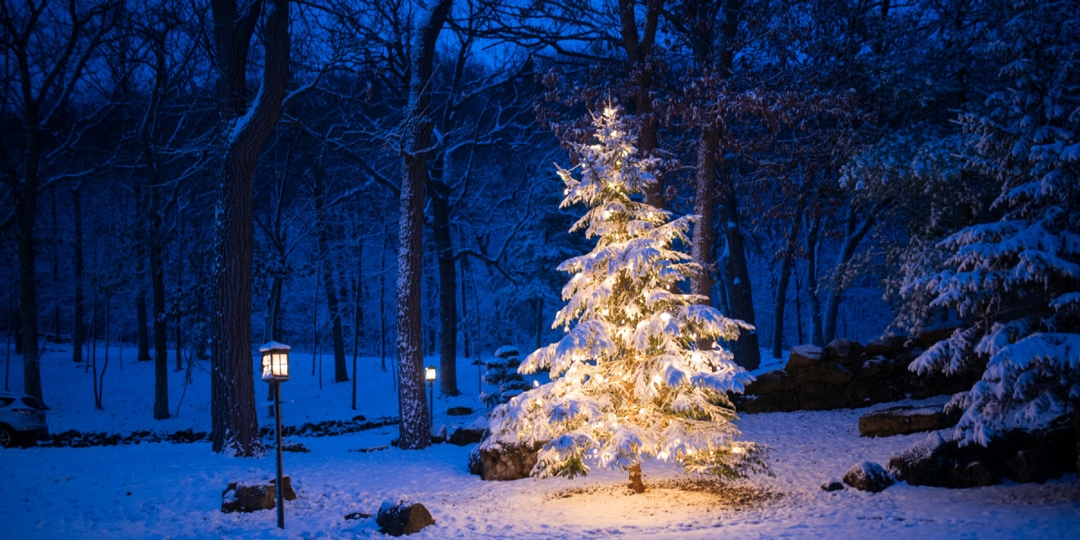Oh, Christmas tree, oh, Christmas tree … why do we put you up every year? One month a year, many people who celebrate Christmas put up a tree indoors, whether a fresh-cut live pine or a fake evergreen to take its place. Just where did the tradition come from?
Why Do We Have Christmas Trees?
Plants that are green in wintertime have been used symbolically around the world, from date palm rushes that grew in the fertile Nile River Valley in ancient Egypt to evergreens across the Roman Empire.
Many, especially those in more northerly regions have associated evergreens with hope and life in the depths of winter. This is because they remain green even in the darkest, coldest part of the year. That hope is particularly poignant at Christmastime, which falls around the winter solstice (the year’s longest night).
The most direct precursors to the Christmas tree come from several sources, including ancient Rome, where the solstice feast of Saturnalia saw homes and temples decorated with evergreen boughs. (This marked the return of Saturn, the god of agriculture, to their lives.)
Farther north, Celtic druids associated evergreens with everlasting life. The Hebrews linked them with life and growth, and in Han Dynasty China, evergreens were a symbol of resiliency. The Norse people associated evergreens with Baldur, their sun god.
Many pagan traditions survived the conversion to Christianity, including the hanging of evergreen boughs and wreaths.
Where Did the Tradition of Christmas Trees Come From?
The start of the Christmas tree tradition, at least as we know it today, started in the 1500s in Germany.
At first, evergreens were placed beside a medieval home’s entryway or inside the house. Then, the tradition graduated to indoor trees covered with apples after a popular play featured a similar decoration for the feast of Adam and Eve on December 24th. These early Christmas trees featured decorations from cookies (yum!) to lit candles (a tradition that has gone by the wayside due to its tendency to start fires).
A separate, parallel tradition that eventually fused with the Christmas tree was the small “Christmas pyramid” (Weihnachtspyramide, in German). These wooden shelves held Christian figurines, candles, more evergreen branches, and a star.
The two practices merged in the 1500s, resulting in the first decorated indoor Christmas trees.
The History of the Christmas Tree in America
Christmas trees came to America as early as the 1600s with German immigrants. However, they weren’t truly popular in the United States until the 19th century, when German-born Prince Albert, husband to Queen Victoria, introduced Christmas trees to England in 1846. What was fashionable across the pond became all the rage in the States. In the early 1900s, electricity made electric lights possible, and decorated trees lit up with electric lights started popping up in town squares.
Germany also introduced the first artificial trees (made from dyed-green feathers) to the U.S. in 1920. British company Addis Housewares Company made the first bristle-brush artificial trees in 1930, exporting the idea to the States. Aluminum trees were wildly popular in the ‘50s and ‘60s, starting the age-old argument of, “Are we getting a real or fake tree this year?”
The History of Decorating Christmas Trees
Decorations have certainly varied throughout the centuries. After starting with simple, handmade decorations, we’ve graduated to intricate ornaments depicting everything from Christmas scenes to characters from our favorite TV shows.
Why Do We Put Ornaments on a Christmas Tree?
The first tree decorations came from that stacked-shelf Christmas pyramid from medieval Germany, which simply migrated to the tree itself. Most decorations were religious to start with. The mass production of glass and lead ornaments, as well as beads, tinsel, and cotton batting “snow” started in the early 1900s and helped decorations “branch” out.
The First Mass-Produced Christmas Ornaments
When Christmas trees first came into fashion in the late 1800s, department stores like F.W. Woolworth began selling delicate blown-glass ornaments, making the tree-decorating tradition easy to participate in. But decades later, in the early 1900s, most ornaments were still homemade, and food was a popular decoration: Strings of berries, nuts, and popcorn made it onto evergreen branches, alongside cookies, marzipan, and apples.
The History of Christmas Tree Lights
The very first Christmas lights were actual, lit candles on medieval trees! They were meant to represent the Christian light of Christ, as well as the return of light to the world. There’s even a story of Martin Luther, the Protestant reformer from the 1500s, placing candles on his Christmas tree trying to re-create the brilliance of the nighttime stars for his family.
Electric lights were introduced in 1890, a far safer option than traditional candles. Christmas lights have continued to improve in safety throughout the years, with the most recent advancement being energy-efficient, long-lasting, and more reliable LEDs. These bulbs also have a reduced risk of fire compared to previous technology.
Our friends at your local Color World Painting location are happy to help with outdoor holiday lights, including for your towering evergreens.
Why Do We Put Presents Under the Christmas Tree?
This was also popularized by Prince Albert and Queen Victoria, though the exact origins aren’t clear. It could have been inspired by the gifts of the Magi presented to baby Jesus in Christian tradition. Some may have put small presents directly on the tree’s branches but when gifts got too large for evergreen branches to support, people likely placed them underneath the tree instead.
Rely on Us to Take Care of Your Outdoor “Christmas Trees” Too!
Evergreens aren’t just an indoor Christmastime tradition; they’re an outdoor tree that graces many yards and commercial landscapes across the country. From bushy firs to prickly pines to stately spruces, Monster Tree Service takes care of them all!
Keep your evergreens verdant and healthy with regular maintenance from the pros. We’ll do everything from fertilizing and trimming overgrown branches to disease management.
Call (888) 744-0155 to chat about what your evergreens need or request an estimate online.

